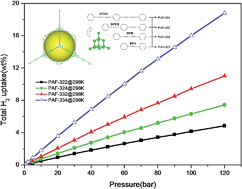Ultrahigh hydrogen storage capacity of novel porous aromatic frameworks†
Abstract
We proposed four novel porous aromatic frameworks (termed as PAF-322, PAF-324, PAF-332 and PAF-334) with low density and high free volume ratio, which were constructed by inserting a long and slim organic linker such as diphenylacetylene (DPA), 1,4-diphenyl-butadiyne (DPB), 1,4-bis (phenylethynyl) benzene (BPEB) or 1,4-bis (phenylbutadiynyl) benzene (BPBB) into each C–C bond of diamond. Then the hydrogen uptakes in these porous materials were predicted using grand canonical Monte Carlo (GCMC) simulations based on the force field derived from the first-principles calculations. The results show that these materials are the most promising candidates for hydrogen storage. Among the four novel PAFs, PAF-334 possesses the highest gravimetric hydrogen storage properties, which are a total gravimetric hydrogen uptake of 63.96 wt% at 77 K and 100 bar, and a excess gravimetric hydrogen uptake of 10.69 wt% at 77 K and 20 bar. In addition, the total gravimetric hydrogen uptake of these PAFs even at 243 K and 120 bar entirely exceeds the U.S. Department of Energy's (DOE) 2015 gravimetric hydrogen storage target. In particular, the total gravimetric hydrogen uptake of PAF-334 at 298 K and 100 bar reaches 16.03 wt%, about three times the DOE target value.


 Please wait while we load your content...
Please wait while we load your content...